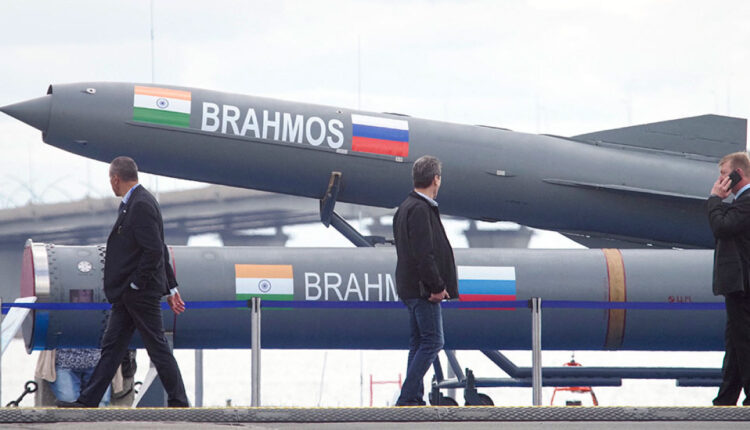Watch Out China!! Philippines Set to Receive BrahMos Missile Next Month
The Philippines seeks to employ the Indian-Russia made BrahMos coastal missile defence system to deter any potential attempts by China to seize or occupy islands or reefs within its Exclusive Economic Zone (EEZ) in the western South China Sea.

(DEFENCE SECURITY ASIA) — The Philippines reportedly is set to receive the India-Russia made BrahMos coastal defense missile, procured from India at a cost of US$375 million (RM1.5 billion), next month, January 2024.
Initial expectations hinted at Manila taking delivery of the supersonic missile system in December 2023, but observers note a slight delay, pushing the arrival date to next month as informations from the Philippines indicated.
“The delivery is reported to be delayed by a few weeks to January 2024,” according to informations from the South-East Asian country.
As the first country outside India to deploy the BrahMos missile system, the Philippines intends to station the missile system strategically in the South China Sea, unilaterally referred to as the West Philippine Sea by Manila.
The nation seeks to employ the supersonic-BrahMos missile system to deter any potential attempts by China to seize or occupy islands or reefs within its Exclusive Economic Zone (EEZ) in the western South China Sea.
Equipped with the BrahMos missiles system, Chinese coast guard vessels must “think twice” before approaching any islands or coral reefs within the Philippine Exclusive Economic Zone (EEZ) in Philippine waters.

The contract for the purchase of the coastal missile defence system was awarded to BrahMos Aerospace Private Ltd, the company responsible for its development, on December 31, 2021.
The delivery of the missile system holds geopolitical implications, especially concerning Chinese naval activities in Philippine waters.
An observers in Malaysia highlight the potential impact, stating, “The arrival of BrahMos coastal missile defence system next month (January 2024) poses a ‘nightmare’ and significant deterrent, especially to China’s naval vessels, which have frequently encroached on Philippine waters.”
Similar to the Philippines, Malaysia also contends with encroachments by Chinese coast guard vessels into its Exclusive Economic Zone (EEZ) waters, particularly around the Luconia Shoals (Beting Patinggi Ali), known for its abundant oil and gas deposits.
Philippine President Ferdinand Marcos Jr had vowed recently that his government will stand up to “coercion” in the South China Sea, following stern warning by Beijing’s top diplomat.
“We shall continue to assert our rights in accordance with the Philippine constitution and international law,” he said, adding recent confrontations in the sea were a “demonstration of Filipino courage against coercion and our firm resolve to protect, preserve and uphold our territorial integrity”.

Marcos’ declaration followed warnings from Chinese Foreign Minister Wang Yi that any miscalculation in their escalating dispute in the South China Sea would bring a resolute response from Beijing.
He urged dialogue to address “serious difficulties” between the two neighbours.
If the Philippines misjudges or colludes with “ill-intentioned” external forces, China would defend its rights and respond resolutely, Wang was quoted as saying.
Wang’s remarks could intensify a dispute that has simmered for years, with the Philippines pushing back at what it sees as a Chinese campaign to prevent it from accessing fossil fuel and fisheries resources in its EEZ waters.
The BrahMos missile system, a collaborative effort between India’s Defence Research and Development Organisation (DRDO) and Russia’s NPO Mashinostreyenia (NPOM), is expected to provide the Philippines with an anti-ship variant with an effective range of approximately 300km and a supersonic speed of 2.8 Mach.
The missile carries around 200kg of high-explosive material.

With its moderate-range cruise missile technology, the BrahMos can be launched from various platforms, including air, naval vessels, submarines, and coastal areas.
The Philippines is reportedly considering deployment locations such as Basco in Batan Island, Bashi Channel, San Felipe in Zambales, Culion, and Tagbita in Palawan.
The 300km operational radius of the BrahMos system raises concerns, particularly if deployed in Tagbita, Palawan, potentially targeting one of China’s military bases in the Spratly Islands, the Mischief Reef.
Mischief Reef, initially a coral reef, has been artificially expanded into an island by China and serves as Beijing’s key military base alongside Subi Reef and Fiery Cross in the Spratly Islands.– DSA
CLICK FOR DEFENCE SECURITY ASIA APPS
To advertise contact: lulwabyadah@gmail.com



Comments are closed.